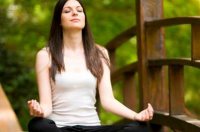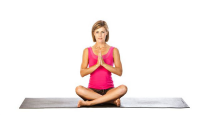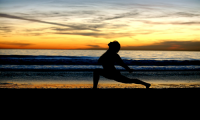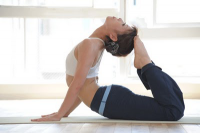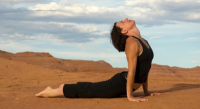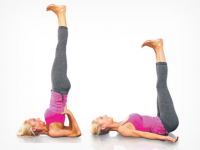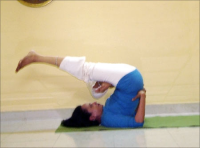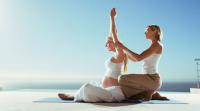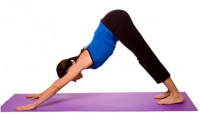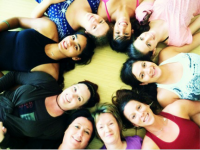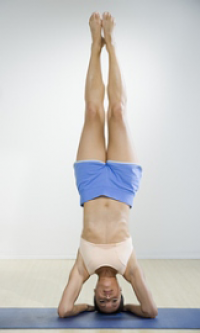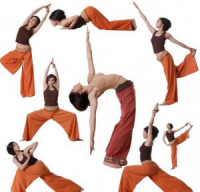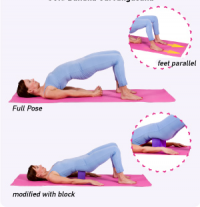Sukhasana Yoga Benefits This yoga pose is frequently used in meditation and breathing practice. It helps you to relax and calm body and mind.The asana helps makes the waist and lower region of a person quite flexible. * The asana has been found to be very beneficial for strengthening the lumbar region of the body. * Sukhasana is one of the simplest postures in yoga and can be undertaken by almost anyone, with hardly a few exceptions. * In case you are stressed out mentally, either from too much work or too monotonous work, practicing Sukhasana will provide you with mental peace and calm. * Sukhasana is believed to aid tuneful, but controlled stimulation of the erotic processes as well as the creative imagination of a person. * Indulging in the asana, after you have undergone a stressful and tiring day, will help you get over the exhaustion and make you feel refreshed. * Practicing Sukhasana will help you achieve a state of composure and harmony, by eliminating all the unnecessary anxiety. * Throughout the posture, the backbone remains in the ideal position, making the asana beneficial for those who are suffering from back pain.
Sukhasana Yoga Pose This is a classic meditative pose which helps straighten the spine. Learn how to do it in this section. Sukhasana can provide the best start to yoga beginners and can also be practiced by those who cannot do siddhasana, padmasana and other difficult postures. You can also use it to attain relaxation between two complex postures. * Sit down on a flat and smooth surface, preferably the ground. * Stretch both the legs in front of you. * Keep your hands on the side, making sure to have the palms resting on the ground. Fingers should be together and point forward. * First fold the left leg slightly, at the knee, followed by the right leg. * Now, join the soles of the both the feet and hold the legs at ankle by the hands. * Moving slowly, start bringing the legs towards yourself. Continue doing so till the time the legs reach under the perineum. * At this point of time, your knees should remain on the ground, while your body should be erect and your gaze directly in the front. * Keep your hands on your knees, in gyana mudra (you have to hold the index finger against tip of thumb, having the other three fingers straight). * Hold the position for 4-5 minutes. * Now, gradually loosen your legs and come back to the original position.
How to Perform Surya Namaskar Surya Namaskar is one of the ancient and powerful exercises to keep the body fit and flexible. Since the moves of this exercise offer a complete body workout, it is beneficial in toning the muscles and stimulates body metabolism. Each pose or posture is in essence offering salutation to the Sun God – Surya, also known as the keeper of good health. This has been adapted into our modern way of life as a natural way to derive the many benefits of this exercise. One of the most popular approaches is practicing Surya Namaskar for weight loss. * Do warm up stretches before you start the series of asanas in Surya Namaskar. This prepares the body for the upcoming postures. * Perform each pose with awareness. Since various postures in Surya Namaskar activates a number of muscles and releases energy, it is important to do sun salutations with awareness. * Do each pose gracefully and slowly. It is essential that you breathe normally when doing each posture. The body and the breath must be in harmony. * Yoga experts opine that twelve rounds (six sets) of Surya Namaskar is sufficient to keep a body fit and flexible. You can do up to a hundred and eight rounds (nine sets) or more for weight loss. Get comfortable with a smaller number of rounds before you can start practicing more sets. * Relaxation is also important aspect of Surya Namaskar. Do not skip this step since Surya Namaskar is not complete without shavasana. Few people do not realize the importance and skip this step due to lack of time. * Shavasana lets the body to recuperate and gives you energy to face the rest of the day. You must spend at least five minutes in this pose before you can resume other activities. * The best time for you to perform Surya Namaskar is the time of the dawn or the dusk. Your stomach must be empty for at least four to five hours before you start the routine. * Each round of Surya Namaskar burns about ten calories. You can easily aim burning about four hundred and fifty calories for a forty-five round routine. * Start practicing this routine at least five times a week. Gradually aim for all the days of the week for faster weight loss. * This routine is best done listening or chanting the Surya Namaskar Mantra, which makes you do the postures slowly and gracefully. Fast music is a strict no-no.
Yoga Quote of the Day Spirituality is very rich food that cannot be digested by everyone. In order to be successful we need discipline. First we have to become free from those negative powers that are within our phenomena: Kama, Krodha, Madha, Lobha, Moha and Ahamkara: passion, anger, selfishness, greed, attachment and ego. If you have not purified these qualities the door is closed for you, no matter how long you have practised! It is a hard work to change one’s inner feelings and qualities. Paramhans Sri Swami Maheshwarananda
Yoga Quote of the Day Whatever you think and whatever you do, everything will come back to you. Whatever thoughts, all words, deeds you did, all these will bring you back to yourself. If you are unable to think positively, at least do not think negatively. It is very important. If you are unable to speak good, at least do not speak bad. Paramhans Sri Swami Maheshwarananda
Health Benefits Of Cobra Yoga Health Benefits Cobra Pose, Hot Yoga Health Benefits, Cobra Yoga Health Benefits: Read on to get complete information on the technique to do cobra yoga, its health benefits and the people who should not attempt to do this asana. * A natural remedy for amenorrhoea, dysmenorrhoea, leucorrhoea and various other utero ovarine troubles * Effective for women in toning up their ovaries and uterus * Effective in curing constipation * Stimulates the endocrine system * Gives good appetite * Strengthens and increases the flexibility of spine * Tones up superficial muscles of the back * Relieves muscular tensions * Relieves pain in the back * Strengthens the abdominal muscles * Tones up the abdominal viscera
How To Do Cobra Yoga Pose On the completion of the asana, the person doing it appears like a hooded cobra, with a raised trunk, neck and head. Read on to get complete information on the technique to do Bhujangasana, its health benefits and the people who should not attempt to do this asana. * How To Do Cobra Yoga Pose : To start the pose, lie down on your stomach, on a flat surface, say, floor. Make sure you relax all the muscles completely. Rest your forehead on the floor. * How To Do Cobra Yoga Pose : Now, put your legs together and position your arms below the corresponding sides of your shoulder, close to your body. The hands should be placed beside your chest. * How To Do Cobra Yoga Pose : Now, start inhaling slowly. Keep inhaling and then raise your upper body (trunk), including your chest and head, to the maximum extent possible. Raise your trunk slowly, without creating any jerk. Do this just as a cobra raises its hood. * How To Do Cobra Yoga Pose : By doing the above step, you will gradually feel the bending of the vertebrae one by one and feel the pressure traveling downwards from the cervical, dorsal and lumbar regions and lastly to the sacral regions. * How To Do Cobra Yoga Pose : While doing this, your head and chest should be positioned upwards. * How To Do Cobra Yoga Pose : In order to attain the full form of Bhujangasana, known as Poorna Bhujangasana, raise your legs, bent at the knees, backwards and try to touch the toes to the back of your head. * How To Do Cobra Yoga Pose : In order to release the posture, get back to the original position, by exhaling slowly and bringing down your trunk smoothly down to the floor. * How To Do Cobra Yoga Pose : You may repeat the exercise for five times. For the beginners, taking the help of their arms to raise the upper body is beneficial.
Benefits Of Ardha Sarvangasana The exercise proves to be beneficial in strengthening the abdomen. It also helps in proper thyroid functioning. Ardha Sarvangasana can be done two times a day - once in the morning and then in the evening. In the following lines, we have mentioned the exact steps needed for performing Ardha Sarvangasana. * Helps in proper thyroid functioning * Strengthening of abdomen * Stretches upper back * Increases blood circulation * Encourages relaxation * Accentuates the flow of blood and energy to the brain * Stimulates mental functions * Enhances memory and concentration * Relieve from some headaches * Cures dyspepsia, constipation, appendicitis, other gastro-intestinal disorders and varicose-veins * Supplies large quantity of blood to the spinal roots of the nerves * Stops loss of hair or premature greying * Enhances facial complexion * Helps alleviate rheumatism * Cures malfunctioning of the sexual organs * Sublimes emotions of depression and neurasthenia * Treats problems of insomnia
How To Do Ardha Sarvangasana A unique pose, Ardha Sarvangasana ensures rejuvenation of the whole system. It is also referred to as The Shoulder Stand, Candle Posture and Pan Body Posture. * The first step would be to lie flat on the back. Then, with the help of your hands, lift your legs up into air. * The position of the hands should be such that it should be on the lower back. Make sure that your elbows and lower arms rest on the ground. * The weight of your body should be on your shoulders and from mid to upper back, but not on the neck. * Once you have attained the desired posture, hold at the posture and breath deeply for 5 to 10 minutes. Increase the duration of holding the posture, gradually, over time. * At the time of coming down, slowly lower your legs. In the process, do not forget to keep them straight. This would mean a little workout for your abdominal muscles as well. * Make sure that in the process of doing the asan you face no jerks. * For the beginners, it is not possible to attain the correct posture, as the abdominal muscles are not strong enough. In that case, the best bet would be to allow the legs to come forward towards the face.To attain best results, performing Matsyasan immediately after it.
Pregnancy Exercise Tips According to the American Journal of Obstetrics and Gynecology, 1985, moderate exercise, during pregnancy, may reduce the chance of having a miscarriage or a premature baby. Exercise strengthens the pelvic and abdominal muscles which help make the birth easier. * Regular exercise during pregnancy is essential. Walking is the best exercise in that body condition. Brisk and strenuous exercise should be avoided when tired, take a casual stroll. * While sitting on a chair keep your knees wide apart and cross your legs at the ankles and not at the knees. Join an exercise class for pregnant women if available nearby. * A woman should not work full time after the 30th week of pregnancy. During the last three months the heart is working 33% harder than normal. It needs some relief. Avoid high heeled shoes in pregnancy because they shift the body weight forward, thus placing additional strain on the spine and back. * Avoid prolonged sitting. Get up slowly after lying down. During pregnancy you need 9 to 10 hours of sleep. Try to lie on your left side with your knees bent inwards Mid-day rest is the answer to fatigue in early pregnancy. Do not wear undergarments tight about the waist. Link has been established between fetal anomalies, childhood malignancies and X-Ray examination during early pregnancy. X-ray examination must therefore be avoided. * Exposure to smoking, active or passive, must also be avoided. Such an exposure could lead to even a still birth. Drinking alcohol and using narcotic drugs has similar consequences and must be shunned. Do not take any medicines during pregnancy unless prescribed by a doctor who is aware of your pregnancy position. * During pregnancy, the presence of breast milk is no cause for alarm. Wash away any dried milk with warm water so that your nipples do not become itchy, irritated or sore. If the gain in weight is less than 10 kgs or inside of your eyelids is pale or there is unusual swelling of legs, arms or face, medical advice may be sought immediately. * There are occasions when faintness comes while lying on your back. It only means that the uterus has fallen against the main blood vessels at the front of your spine and has interfered with enough circulation to those vessels. The drop in circulation makes you faint. Solution is very simple. Lie on your side and not on your back. The weight of the uterus shifts and normal circulation is restored.
Adho Mukha Svanasana Pose Adho Mukha Svanasana helps in building power, flexibility and alertness. This is the first pose which some people learn as they begin to do yoga. While executing different styles of yoga, this posture is repeated. It is many times done during a yoga class as it provides a transition between poses, particularly in Surya Namaskar and vinyIasa flow yoga. Make sure that before starting this asana you should know the exact posture required for this asana. * Lie on the floor on your abdomen. * Raise your body to position the body on all fours, palms, knees and toes touching the floor. * Keep your knees apart and right beneath the hips and the palms a bit ahead of the shoulders. * Spread out your fingers. * Exhale and raise your knees off the ground. * Keep your knees slightly bent and your heels off the ground. * Raise your body up further, lengthening your tail bone. * Lift your buttocks further up so they face towards the ceiling. * Lengthen your thighs and stretch the heels so that they touch the ground. * Keep your knees straight but still apart. * Roll the upper thighs inward slightly and roll the heels outward slightly. * Press your palms on the floor and straighten your arms from the wrists to the tops of the shoulders. * Open up your shoulders and move them towards the tailbone. * Keep your head in between the two arms. * Hold the pose for about a minute. Gradually raise it to three minutes. * Return to initial position in reverse order
Eight Limbs of Yoga The practice of yoga is both an art and science, which creates unification of the body and mind with the spirit.Each part ultimately brings completeness to the individual. They tend to find their connectivity to the divine. Being a different individual, a person can emphasize one branch and then move on to another according to their understanding. * Asanas It is the practice of physical postures and is the most commonly known aspect of yoga. The practice of moving the body into postures helps in improving health, strength, balance and flexibility. On a deeper level, the practice of asana, which means staying or abiding in Sanskrit, is used as a means to calm the mind and move into the inner essence of being. * Yama It is known as Moral observances for interactions with others. Broken down into five wise characteristics, they tell us about our fundamental nature that of being compassionate, generous, honest and peaceful. It teaches the directives of Ahimsa (non-violence), Satya (truthfulness), Asteya (non-stealing), Brahmacharya (celibacy) and Aparigraha (non-covetousness) * Dharana Immovable concentration of the mind is the underlying principle of Dharana. The essential idea is to hold the concentration or focus of attention in one direction. The mind needs to be stilled in order to achieve this state of complete absorption. * Niyama It is known as Moral observances for interactions with yourself. The word itself means rules that are prescribed for personal observance. The niyamas are far more than an attitude, and are more intimate and personal. The directive include Shaucha (internal and external purity), Santosha (contentment), Tapas (austerity), Svadhyaya (study of religious books and repetitions of Mantras) and Ishvarapranidhana (self-surrender to God, and His worship). * Pranayama It controls the energy, in order to restore and maintain health and to promote evolution. Pranayama is the measuring, control, and directing of the breath. It further provides perfect relaxation and balance of body activities are realized. * Pratyahara In yoga, the term pratyahara implies withdrawal of the senses from attachment to external objects. It is most commonly known for sensory inhibition. * Dhyana Dhyana focuses on Meditation. It means worship, or profound and abstract religious meditation that involves concentration upon a point of focus with the intention of knowing the truth about it. The concept holds that when one focuses their mind in concentration on an object the mind is changed into the shape of the object. * Samadhi It is the final step in the eight-fold path of Yoga. It means pleasurable fascination of one's individual consciousness in the essence of God. Samadhi means to bring together to merge. In this state, the body and senses are at rest, but the faculty of mind and reason are alert.
Sanskrit Names of Yoga Poses Yoga Journal offers a complete collection of yoga positions, which you can browse by English or Sanskrit name. * Tadasana - Mountain Pose * Utthita Trikonasana - Extended Triangle Pose * Ardha Chandrasana - Half Moon Pose * Utthita Parsvakonasana - Extended Lateral Angle Pose * Virabhadrasana I - Warrior I Pose * Virabhadrasana II - Warrior II Pose * Adho Mukha Svanasana - Downward Facing Dog Pose * Chaturanga Dandasana - Four-Limbed Staff Pose * UrdhvaMukhaSvanasana - Upward Facing Dog Pose * Setu Bandasana - Bridge Pose * Jathara Parivartanasana - Revolved Abdominal Pose * Supta Padangusthasana - Supine Big Toe Pose * Dandasana - Staff Pose * Paripurna Navasana - Complete Boat Pose * Baddha Konasana - Bound Angle Pose * Plank - Plank * Chaturangadandasana - Crocodile * Cat-Cow - Cat-Cow * Vajrasana - Thunder Bolt Pose * Bharadvajasana - Seated Side Twist * Suptaikapadaparivrttasana - Supine Twist * Bhujadhanurasana - Shoulder Bow * Uttanasana - Standing Forward Bend * Uttanasana - Intense Stretch Pose * Lunge - Lunge * Utktasana - Chair Pose * Bhujangasana - Cobra * Savasana - Corpse Pose
Shirshasana Head Posture Shirshasana Head Posture, Headstand, Shirshasana, Sirsasana, Yoga Positions, Asana, Yoga Postures:The posture looks imposing to beginners and is extremely powerful. Place your mat into a comer, kneel down and place your interlocked fingers in the comer close to the walls. Keep your head into the hollow of the palms, rise off the knees and take a step or two towards the comer. Raise one leg and place it in the comer against the wall. Ask a friend to help you if you are doing it for the first time. Just pull the other leg up. Keep the posture for about 15 seconds and then come out the headstand, lowering one leg at a time. * Fold both the legs at the knees and be seated on the heels of the feet. The body, neck, spine and head should be kept erect. Palms can be placed on the knees. Breathe normally. * Interlock the fingers of hands and place them on the soft padding by leaning forward. * Keeping elbows shoulder widths apart, gently place the back of the head on the inner side of the interlocked fingers. Now slowly lift knees from the floor and take one or two steps towards the head. * Inhale and simultaneously lift the legs gently so that they are in a vertical position. Keeping the back straight, relax and breathe deeply from the abdomen. * old on in the same position for fifteen seconds. The time duration can be increased gradually up to three minutes with practice. While returning to the initial normal position, first bend the knees and place one leg on the floor first and then bring the other down.
Yoga Poses for Beginners The beginners pose library also serves as a great learning tool and reference guide as you continue to develop your yoga practice. Stay tuned for the addition of new poses. * Seated Yoga Poses - Grounding and calming, these poses provide some of our deepest muscle opening and twisting. * Standing Yoga Poses - Good for strength, balance and focus. These energetic poses provide a straight line to shaping our best body. * Arm Balances - These yoga poses are good for strength, body awareness and focus, providing some fun challenges for every body. * Backbends - Opening up in the spine and chest feels great and strengthens our connection to intuition. * Inversions - Good for balance and concentration, as well as circulation. * Core Poses - These poses will strengthen your core and get your abs beach ready! * Yoga Poses for Weight Loss - These poses will help you shed unwanted pounds! * Restorative Poses - These yoga poses are great for winding down and connecting to our breath. * Yoga Poses for Back Pain - Whether the origins are some acute injury or long-term stress, there are a few simple poses that can help with back pain. * Yoga Sequences - How we move and breathe is much more important than the exact shape of our poses, for clearing our bodies and minds and creating our own best health.
Ardha Sarvangasana Yoga Positions Just as the name 'Sarvang' suggests 'all parts', the asan is essentially concerned with all the parts of the body. A unique pose, Ardha Sarvangasana ensures rejuvenation of the whole system. It is also referred to as The Shoulder Stand, Candle Posture and Pan Body Posture. * The first step would be to lie flat on the back. Then, with the help of your hands, lift your legs up into air. * The position of the hands should be such that it should be on the lower back. Make sure that your elbows and lower arms rest on the ground. * The weight of your body should be on your shoulders and from mid to upper back, but not on the neck. * Once you have attained the desired posture, hold at the posture and breath deeply for 5 to 10 minutes. Increase the duration of holding the posture, gradually, over time. * At the time of coming down, slowly lower your legs. In the process, do not forget to keep them straight. This would mean a little workout for your abdominal muscles as well. * Make sure that in the process of doing the asan you face no jerks. * For the beginners, it is not possible to attain the correct posture, as the abdominal muscles are not strong enough. In that case, the best bet would be to allow the legs to come forward towards the face. * To attain best results, performing Matsyasan immediately after it.
Benefits of Adho Mukha Svanasana Adho Mukha Svanasana, Adho Mukha Svanasana Yoga, Adho Mukha Svanasana Benifits: The name comes from the Sanskrit words, adho which means downward, mukha which means face, svana which means dog and asana meaning pose. Adho Mukha Svanasana helps in building power, flexibility and alertness. * Adho Mukha Svanasana helps to strengthen the immune system. * Adho Mukha Svanasana helps to relieve the symptoms of menopause. * Adho Mukha Svanasana builds strength throughout the body. * Adho Mukha Svanasana also provides an overall body stretch. * Adho Mukha Svanasanahelps in relieving fatigue and gives freshness to the body. * Adho Mukha Svanasana relieves some headaches and insomnia. * Adho Mukha Svanasanais a great preparation for standing poses. * It calms the mind and lifts the spirits. * It also improves digestion. * It strengthens arms, legs, and feet. * It stretches the shoulders, legs, and spine. * It helps back to be less stiff. * Adho Mukha Svanasanalessens stiffness in heels and legs. * It helps to open up the shoulder blades. * It stretches the back of the body, especially hips and hamstrings. * It is helpful in increasing blood flow. * Adho Mukha Svanasanamay relieve menstrual discomfort, but make sure that in this head should be supported. * It is helpful in preventing osteoporosis * It may be useful in chest opening. * It is recommended for people suffering from high blood pressure, asthma, flat feet, sciatica, sinusitis, etc.
Personal Values Benefits Yoga * Along with a host of benefits, Yoga also helps in developing and attaining personal values. Yoga erases a variety of ills in human beings. These may range from feelings of frustration, persecution and insecurity. Yoga greatly helps in the development of personal values. * Personal values are those values which an individual develops and lives by all through his life. The main aim of life is to enjoy every moment and Yoga indeed plays a vital role in this regard. Yoga makes life better. Yoga is a continuing process and a life long thing, not just something you do for a while and stop. We all strive for improvement throughout our lives. It is an indication of our resolve to improve and remain fit. Yoga helps us to attain these goals. * Our body is the vehicle that carries our mind. It is here that Yoga assumes great significance. Personal Values are very important as they define your character and they develop your personality. Your personality is the way others see you. There is a golden rule in this regard- if you don't respect yourself, no-one else will. * So you have to earn that respect from others, not just by words but actions too. Yoga also helps you in your resolve to be better. Remember, your personal values are the foundation of your life; you have to continuously grow them up and nurture. Grow and develop them for entire life.

